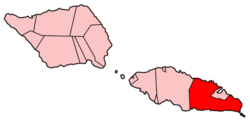Falefa
Falefā is located on the north eastern coast of Upolu island in Samoa.[1] It was the ancient capital during the malo of Tupu Tafa'ifa (King) Fonoti who, after having defeated his siblings Va'afusuaga and Samalaulu for control of Samoa, chose to rule from his new seat in Falefa, an honour remembered in its faalupega (Charter and Salutations) to this day.[2]

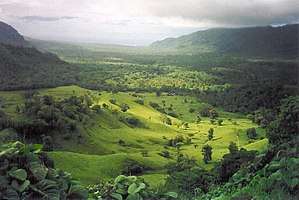
Falefa | |
|---|---|
| Country | Samoa |
| District | Atua |
| Founded | 300 B.C. |
| Population | |
| • Total | 1,563 (2,016 census) |
Falefa is headed by the two Matua - Moeono and 'Iuli - and Leutele, the ranking alii. It is situated in the Anoama'a i Sasa'e electoral constituency which itself is situated within the larger ancient political 'district' of Atua. Atua is headed by the 'Tui Atua' (Ruler of Atua), a title once held by the seer Tui Ātua Leutele (called Leutele Lei'ite) in the 10th century, during Samoa's period of antiquity.[3] Since the 17th century, this mantle has been occupied mainly by one of the two Tama-a-'āiga (maximal lineage chiefs) of Ātua, Tupua Tamasese and Matā'afa.
Together with the village of Salani, Falefa is the home of one of Samoa's main political families, 'Aiga Sā Fenunuivao (descendants of Fenunuivao, wife of King Muagututi'a and mother of the first Tupua, Fuiavailili). It is led by Moeono and Leutele of Falefa and Tofua'iofoia and Fuimaono of Salani, and is the custodian of the Tama-a-'Āiga Tupua Tamasese title.[4]
Both the Tama-a-'āiga Tupua Tamasese and pāpā Tui Atua royal titles are currently held by Samoa's former Prime Minister and Head of State, His Highness Tui Atua Tupua Tamasese Efi.[4] The sitting Member of Parliament for Anoama'a i Sasa'e Electorate is Afioga Alai'asā Moefa’auō Sepulona Moananu, a high-ranking chief of Falefa.
History & Culture
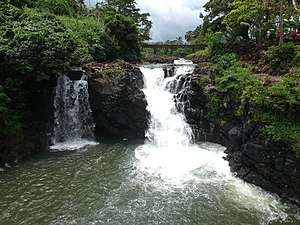
Establishment of Falefa
Falefa is one of the oldest and largest villages in Samoa,[5] with its traditional borders stretching from Uafato to Saoluafata. Oral tradition and archaeological evidence from the nearby Sasoa'a Lapita discovery site in the Falefa valley place the date of settlement in the area to as far back as between 300B.C - 200 A.D.[6] In later times, portions of these lands were gifted by subsequent rulers to form the settlements of Lufilufi, Lalomauga, Falevao and Faleapuna as well as the villages of Sauano and Saletele in the Fagaloa Bay. These villages are historically tied to Falefa through their founding and centuries of intricate political interactions.[7]
According to oral tradition, Falefa was founded by the two sons of Tui Atua Mua’iteleloa and Leateafaiga, daughter of Lufasiaitu of Uafato, Fagaloa - Moe'ono Faleologa & his younger brother Leutele Leutogitui. Since then, Falefa has been headed by the descendants of these two brothers who hold the respective Moeono (tulafale-alii or 'matua') and Leutele (alii) titles.[8] Leaving their birthplace at Uafato, they established their first settlement at the top of mountains overlooking Fagaloa Bay and the Falefa valley, called Manuao. It was from this vantage point atop Manuao that a Falefa war party descended in a surprise attack on the Tongan forces anchored at Fagaloa Bay, foiling Leifi and Tautolo's plot to have Queen Salamasina kidnapped and taken to Tonga.[6] The settlement was later moved down to the coast to its present site at the northern edge of the Falefa valley.
Falefa is administered and governed by Leutele, Lealaisalanoa, Alai'asā as the Alii (Chiefs) of Falefa and by both Matua (elder Orator-Chiefs or 'tulafale-alii') Moeono and 'Iuli. Leutele is addressed as Tinā o Tupua (Tupua's Mother), honoring the first Tupua's mother Fenunuivao and maternal Grandfather, Leutele.[2] Moeono is customarily addressed as "le tamā o le nu'u" ('the father of the village') and is one of the principal spokespersons for Aiga Sā Fenunuivao, Tupua's political family and heirs.[9]
The size of Falefa was such that a centralised location was needed to rule from and so Moeono created 'O le Faleupolu o Sagapolu' - the administrative centre from which the seat of Moeono and his successors continue to govern Falefa from the Moeono residence known as 'Laloaoa' down to the present day. Other sub-villages followed; Saleapaga followed by Sagogu and Gagaeimalae. Moeono and Leutele bestowed titles on prominent houses and established 'vassal' houses to serve Moeono and Leutele and assist with the administration of the growing district.
The brothers and their respective heirs traveled extensively throughout their dominion - from Lemafatele (known as Le Mafa Pass today) to Sasoa'a (where Lapita pottery remains have been found),[6] to Fagaloa and the mountains overlooking the valley below where the village of Falefa stands today.
War: Falefa stands with Fonoti
One of the early kings of Samoa was Faumuina, a direct descendant of Queen Salamasina. He had three children, two sons and one daughter. The sons were named Fonoti and Vaafusuaga and the daughter was named Samalaulu. They are commonly known in the traditions of Samoa as “The Three of Faumuina.” Each child was by a different mother so that after the death of their father they individually contended for the Kingship.[10]
Having waged war successfully for the crown against his kin, Fonoti was ultimately proclaimed King in c.1520.[11] He conferred many honours upon those chiefs and Districts that had fought for him and such honours and privileges are remembered and passed down by Samoa's Tulafale (Orator chiefs) down to the present day.
For contending with Manono, Sapapali'i and Saleaaumua naval forces and securing his victory at sea, the leaders of Faleapuna and Fagaloa were granted a district of their own called Vaa-o-Fonoti (literally, Fonoti's canoe). For leading his land forces and securing victory on land, Falefa was designated the honour of serving as the national capital and was given the salutation of Aai o Fonoti, Aai o le Tupu (Fonoti's city, city of the King).[10] Falefa continued as the administrative centre of Fonoti, Muagututi'a and Tupua's respective malo until the time of Fonoti's grandson, King Afoa (later Afoafouvale), who chose to rule from Lufilufi.[3]
These honors are reflected to this day in the Fa'alupega o Samoa (customary honorific salutations of Samoa) of the respective villages and in those of Falefa (see below).
During the 17th century, continued wars between the Falefa and surrounding districts had taken its toll. 'Iuli was rewarded by Moeono for having the courage to speak for peace and was subsequently granted the position of honour, elevated to becoming the one of the two preeminent senior tulafale of Falefa, assisting Moe'ono'ono and Leutele with the administration of the Falefa as well as in their dealings with the rest of Samoa.[10]
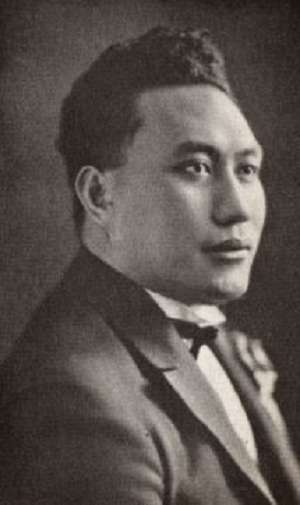
Falefa, Salani and the Tama a 'Āiga, Tupua (later known as 'Tupua Tamasese')
The pāpā titles confer upon individual holders authority over designated territory (Tui Atua rules Atua, Tui A'ana rules A'ana etc.) or, in the case of a Tafa'ifā (holder of all four pāpā titles) status as King or Queen of all Samoa. However, these titles are usually contested exclusively among Samoa's four royal lineages, each with a paramount title holder whom the lineage is named after and in whom the mana (honour) of the family is represented. These are called tama-a-'āiga ('sons of the families', i.e. the four paramount families of Samoa). Tupua Tamasese is the tama of the Sā Fenunuivao aiga, one of the primary political families of Samoa based in Falefa and Salani.[12]
King Muagututi'a, son of King Fonoti, married Fenunuivao, daughter of Leutele of Falefa. Because they had no children of their own, they adopted Fenunuivao's nephew Fuiavailili, from Salani, as their son and heir. Upon his arrival in Falefa, he was given the name 'Tupua' and was thereafter known as Tupua Fuiavailili, the first Tama-a-'āiga.[3]
As the child was now the sole heir to King Muagututi'a, the powerful orator groups of Pule and Tumua performed their customary right of saesae laufa'i (investigating one's genealogical links) enquiring as to whether he possessed the necessary genealogical links in order to be worthy of tafa'ifa honours. Thus it was revealed that Fuiavailili's biological father was Fuimaono, and biological mother Sa'ilau, descendants of Fanene and direct descendants of Queen Salamasina's son and second child, Tapumanaia.[13]
King Muagututi'a himself was descended from Queen Salamāsina's eldest child, Fofoaivao'ese. Thus it was that Tupua Fuiavailili, through both ancestral lines, was the first ruler of Samoa to have inherited from both of Queen Salamāsina's children, re-uniting the Salamasina lineages through his ancestor, Tapumanaia, Salamāsina's husband (from the Fuimaono and Fanene line), and Muagututi'a's ancestor Fofoaivao'ese, Salamasina's daughter with from a previous relationship with Alapepe, (from the Muagututi'a line). Having satisfied the requirements of having direct lineage to Salamāsina and demonstrable link to both lineages and prominent families, Tupua Fuiavailili was proclaimed first Tama a 'Āiga and succeeded Muagututi'a to become King in c.1550.[3]
The Aloali'i: Luafalemana.
From his four usuga (marriages), King Tupua Fuiavailili had five children. Two went on to become King, while the third went on to become the ancestor of the Matā'afa tama-a-'āiga title: Luafalemana.
The beginnings of the tama-a-'āiga Matā'afa lineage is traced through to Luafalemana, son of King Tupua Fuiavailili.[5] This was enabled through the union of Luafalemana's daughter, Salaina'oloa of 'Aiga Sā Fenunuivao with Tuimavave (also known as Tauili'ili) of 'Aiga Sā Levālasi , issuing one of the progenitors of the Matā'afa title, Fa'asuamale'aui, in 1785.[4] Tuimavave's other union with Letelesa issued the another progenitor of the title, Silupevailei. These two lines of Fa'asuamale'aui and Silupevailei are from whom all Mata'afa are selected.
Family traditions differ on who was the first Mata'afa, but the majority of opinion favours Tafagamanu, grandson of Fa'asuamale'aui.[4]
Tuimavave's union with Tupua's grand-daughter, Salaina'oloa, has resulted in the Luafalemana title's association with both the Tupua Tamasese and the Matā'afa titles. Several Matā'afa holders from Falefa also held the Tupua title concurrently, like Matā'afa Iosefo who became known as Tupua Matā'afa Iosefo.[5] By joining the daughter of Luafalemana with Tuimavave, the Tui Atua line arrives at a harmonious junction between the two great Tama-a-'āiga families of Atua - 'Aiga Sā Levālasi and 'Aiga Sā Fenunuivao.
- Afoa of Palauli. Succeeded his father to become King and ruled from Lufilufi. Defeated in single combat by his brother, Galumalemana. (later named Afoafouvale, after his defeat)
- Galumalemana of Saleimoa (who later succeeded his brother Afoa as King by defeating him at Maauga, Leulumoega[3]).
- Luafalemana of Falefā,[14] From Tupua's third marriage to Punipuao, daughter of Ala'iasa. Ancestor of the Matā'afa tama-a-'āiga through his daughter Salainaoloa, who married Tuimavave and sired the elder Mata'afa line of Faasuamale'aui.[5]
- Tautisusua and Tufugatasi, from Tupua's fourth marriage to Matavaoilesasa.[5]
Collectively, these titles are known as Aloali'i (Dauphins or heirs). The establishment of the institution of aloalii ensured the continuation of the Tupua's political influence through his descendants and to maintain in perpetuam the genealogical linkages between the first Tupu Tafa'ifa, Queen Salamasina and later Tupu Tafa'ifa, King Fonoti, from whom later rulers would draw legitimacy.[12]
Politics & Governance
Falefa means the 'House of Four', indicative of the four sub-villages which make up the main components of Falefa; Sagogu, Gagaemalae, Saleapaga, Sagapolu. Each of these sub villages comprise families, the heads of which, represent their extended families and their respective area at Falefa's Village Council, headed by the two senior tulafale-alii of the village (Matua), Moeono & Iuli.[9]
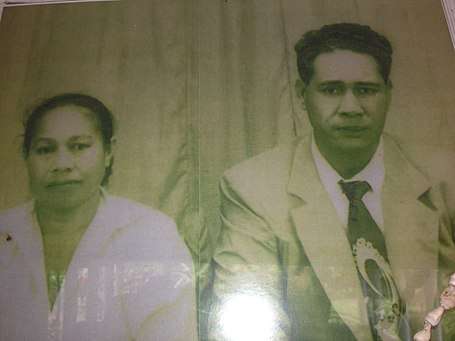
The establishment of Moeono and Leutele titles predate the Tongan period, as the primordial holders were the sons of Tui Atua Mua'iteleloa (one of the earliest holders of the Tui Atua pāpā title) and founders of Falefa somewhere between 300B.C - 200 A.D.[6]
Protocol: The Selection of the Moeono & the Leutele
Upon the death of a Moeono or Leutele, the district goes into an extended period of mourning and kicks off the procession of cultural protocol which follows. During this sede vacante period, the administration of Falefa is then passed to 'Iuli, Lealaisalanoa, Alai'asā and Falefa's other matai alii (senior chiefs of each families) until a Moeono or Leutele is appointed.
At the appointed time when an heir has been chosen, the proceedings of the saofa'i (bestowment ceremony) stipulate that only the two bearers of the titles of the two brothers - Moeono and Leutele - are part of this sacred ritual. Only once it has been completed with the completion of the 'ava ceremony and the title bestowed will 'Iuli lead the rest of the village chiefs in to the residence to join them (usu le nuu). The ceremony itself is guarded by Tupua ma le Aumaga (the name for Falefa's untitled men's guild).
The last holder of the Leutele title was Leutele Tapusatele Keli Tuatagaloa. The late Moeono Leateafaiga Atoafuaiupolu Tomanogi Penitito Alaiasa is the most recent holder of the Moeono title, which he held until his passing in 2018. Unlike the Leutele and other titles of Falefa, the Moeono line has enjoyed a revered tradition of only ever having a single holder of the Moeono at any given time. Thus the most recent holder was the 16th of his name, with known successors of the current line stretching back further to the brief intervention from Saoluafata and to antiquity.
As of 2018, both titles remain vacant pending appointment of the new holders by the respective heirs.
Lautivunia: The story of the Tui Tonga and Tui Atua Leutelelei'ite
The Tui Tonga (ruler of Tonga) had two sons. The elder was named Tuitonga after his father, the younger, Lautivunia. Lautivunia had an affair with his brother's wife. When the affair became known, the older brother was very angry.
As is the custom, the younger brother made a peace offering of cooked food wrapped in tolo (ordinary sugar cane) and fiso (wild sugar cane) leaves. These leaves underlined the message, ‘Please forgive me, for we are brothers.’
But Tuitoga was not placated and Lautivunia made another peace offering, which included the flesh of ordinary bananas and of the lei (wild banana). The two varieties of banana underlined the message, ‘We are flesh and blood – surely you can find it in your heart to forgive me?’ Tuitoga was still not placated. So Lautivunia decided that if his brother would not accept his food offerings he would offer his life. He dug a hole where his catamaran was housed, fixed spears with points upward at the bottom of the hole, and threw himself on the spears. The force of his action caused the surrounding earth and sand to cave in and cover him.
When Lautivunia's disappearance was noticed, his father and brother sent out search parties to look for him. One party reached Falefa, Samoa. Tui Atua Leutele said, ‘You need not have come so far. Lautivunia is in Tonga under his catamaran.’
So the search party returned to Tonga and found the body of Lautivunia. The Tui Toga felt obliged to reciprocate this favour from Tui Atua Leutele and instructed the search party to return to Samoa with the finest of his fine mats, which he named Le Ageagea o Tumua (the substance of Tumua). In addition, he recognised Tui Atua Leutele's seer abilities by naming him Leutele Leiite, that is, Leutele with the prophetic powers.
The title of Leiite survives today as one of the titles of the Sā Leutele family.[15]
The Ravages of War: 'Iuli calls for Peace
In later centuries, a great war between Tuamasaga and the two allies, Atua and A'ana ravaged the country. Having been defeated, Malietoa Uitualagi and the Tuamasaga army sought refuge at Ana o Seuao in Sa'anapu, Safata. Atua and A'ana forces gave chase and as they arrived at Ana, prepared to complete their victory by burning the entire region and killing off the rest of Malietoa's troops. To their surprise however, an elderly unnamed chief from Tuamasaga approached their war party, beseeching them to turn back from their aim and to have mercy on their defeated foes. Moved by the old man's courage, a young chief named 'Iuli rose to speak in what is now known as the longest lauga (formal oratory) in Samoan history, admonishing his side for two days and two nights to agree to peace with Malietoa's defeated Tuamasaga force. Grateful for this agreement, Malietoa Uitualagi gave the island of Tutuila to Atua.[16] For his efforts in ending the conflict, 'Iuli was promoted to the rank of 'Matua' by Moeono as a reward for his bravery. Today, his descendant governs Falefa alongside Moeono.
The March to Independence: Moeono & The Mau Movement
In the early days of the Mau movement, Luafalemana Moeono Ta'ele resigned from his post at the administration's Native Police to assist with efforts to garner national support for the fledgling independence movement. As Pule (the orators and polity heads of Savaii) were yet to pledge their unanimous support, Luafalemana Moeono Ta'ele was tasked with leading a fleet of fautasi (canoes) together with Upolu's orators to ask for Savaii's support. Choosing to arrive at Satupa'itea instead of Sale'aula, Moeono recalled Falefa's earlier support for the Mau a Pule [17] (which Savaii's orators had led during the German administration, a precursor to the Mau Movement) and called on Asiata to have Pule (Savaii's chief orators and counterpart to Upolu's Tumua) reciprocate their solidarity by joining forces with them in order to further strengthen the cause for independence.
His son, Moeono Alai'asā Kolio OBE, would later become one of the Framers of the Constitution of the newly Independent State of Western Samoa.[18]
The Village Fono: Falefā, Falelima & Falefitu
The convocation of a special meeting of the village fono is decided by 'Iuli or Moeono.[5] The scale of the meeting varies depending on the situation. The most common meetings comprise only the four sub-villages of Falefa: Sagapolu, Saleapaga, Gaga’emalae and Sanonu. The range of participants define the three types of meetings. In this context, the word fale means sub-village. A fono falefa is then a fono in which only the matai from the four sub-villages of Falefa participate.[8] A fono falelima is a fono with the four sub-villages of Falefa and the village of Falevao. A fono falefitu involves all the villages that are part of Falefa's traditional domain, which includes the four sub-villages of Falefa, Falevao and the two villages of Sauano and Saletele in the Fagaloa Bay.[5]
Title Contention and Controversies
Disputes over the Tupua Tamasese title
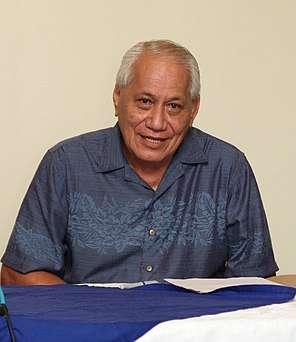
Falefa and the Tupua Tamasese have a long history, dating back to when the first Tupua was installed at Falefa in c.1550.[3] In terms of succession to the title, the family has been among the least controversial of all Tama a 'Āiga families. Family consensus decided successors rather than the court. However, these amicable relations were eventually fractured in 1965 when a major split appeared over the successor to Samoa's Co-Head of State Tupua Tamasese Mea'ole, who died in 1963. Two first cousins and sons of previous holders vied for the title and the family was forced to resort to the court for a settlement.[4]
The family had been unable to agree between two candidates, Lealofi IV, the son of Tupua Tamasese Lealofi III, and Tufuga Efi, the son of Tupua Tamasese Mea'ole.[4] The two men were first cousins, and their fathers had both held the titles. Both were installed at separate ceremonies, Lealofi IV by 'Āiga Sā Fenunuivao of Falefa and Salani, and Tufuga Efi by 'Āiga o Mavaega of Faleasi'u and Asau in Savai'i and by a branch of 'Āiga Sā Tuala from Fasito'outa. The latter's installation took 'Āiga Sā Fenunuivao by surprise and was immediately met with stern rejection.
Both candidates were genealogically eligible, being descended from their common ancestor, Tupua Fuiavailili.[19] However, Lealofi had the advantage of having the unanimous support of 'Āiga Sā Fenunuivao, the title's main political family, on the grounds that his father was older then Tufuga Efi's father and he himself was the elder candidate. The subsequent court battle saw a unanimous endorsement of Lealofi IV's appointment.[14] However, Tufuga Efi's supporters returned to the court to press two more lines of argument. First they argued that the title should be appointed and conferred by the suli (heirs of descendants). 'Āiga Sā Fenunuivao agreed, but pointed out their right to step in and decide, especially seeing as there would inevitably be disagreement among descendants and pointing to the fact that the descendants themselves were part of the wider Fenunuivao family, a view also endorsed by the court. Second, Tufuga's supporters argued that the conjugate titles be split in two; they argued that the Tamasese name constituted a title in its own right and urged the court to award the Tupua title to Lealofi and the Tamasese title to Tufuga Efi. However, the court rejected this argument on the grounds that without Tupua, Tamasese could not be constituted as a title and that Tupua without Tamasese would disqualify Tupua from the rank of a Tama a 'Āiga.[4]
The court ruled in favour of 'Āiga Sā Fenunuivao's candidate, Lealofi IV who would go on to be elected Prime Minister of Samoa.[20]
Upon Tupua Tamasese Lealofi IV's death in 1983, the question as to a successor was raised yet again with Tupuola Efi once again staking his claim. However, this would require 'Āiga Sā Fenunuivao agreeing to his appointment. Salani agreed however, Falefa and Lufilufi opposed. Nevertheless, Tupuola Efi proceeded without the unanimous support of Āiga Sā Fenunuivao. On the morning of his installation ceremony at Vaimoso, the nation's public broadcaster, Radio 2AP, read an announcement from the Moeono at the time, Moeono Alai'asā Kolio, notifying the country that 'Āiga Sā Fenunuivao as well as the leaders of Lufilufi had not sanctioned Tupuola Efi's ascension to the title, effectively nullifying the candidate's grasp for the title yet again.
In 1986, Tupuola Efi approached the now ailing Moeono to ask for Āiga Sā Fenunuivao's unanimous blessing. Despite their initial refusal, both Falefa and Lufilufi eventually agreed. Thus 'Āiga Sā Fenunuivao joined with 'Āiga o Mavaega and 'Āiga Sā Tuala to jointly confer the Tupua Tamasese title on Tupuola Efi in an installation ceremony at Vaimoso in November, 1986, jointly registering the title under their family names.[4]
However, the right of joint conferral was later challenged in court, with the main families within the Sa Tupua clan - Sā Fenunuivao, Sā Tuala and Aiga 'o Mavaega - disputing authority over the title. The matter was decisively settled when in 1987, the court ruled that the right of conferral of the Tupua Tamasese title belonged exclusively to 'Āiga Sā Fenunuivao of Falefa and Salani.[14]
Line of Succession
The Tama of 'Āiga Sā Fenunuivao: Tupua Tamasese
King Tupua Fuiavailili, descendant of Queen Salamasina, adopted son of King Muagututi'a and Fenunuivao, daughter of Leutele
King Afoa (defeated in single combat by his brother, Galumalemana. Thereafter named Afoafouvale, "he who rebels for no good reason.")
King Galumalemana (the Aloalii as an institution of succession is established under Galumalemana)
King Nofoasaefā (tyrant, assassinated by rebels in Savai'i)
King I'amafana (allegedly willed his kingdom to Malietoa Vainuupo; succeeded by Safeofafine but was killed in combat; kingship passes to Tamafaigā)
1751 - 1830: Maeaeafe Mataafa
1830 - 1860: Tupua Moegagogo
1860s - 1891: Tui Aana Tui Atua Tupua Tamasese Titimaea (this is the first time Tamasese is used together with the Tupua title)
1891 - 1915: Tupua Tamasese Lealofi-o-a'ana I, son of Tupua Tamasese Titimaea.
1915 - 1918: Tupua Tamasese Lealofi-o-a'ana II, eldest son of Tupua Tamasese Lealofi-o-a'ana I
1918 - 1929: Tupua Tamasese Lealofi-o'a'ana III (Mau leader, assassinated by NZ Soldiers during Black Saturday), younger brother of Tupua Tamasese Lealofi-o-a'ana II
1929 - 1963: Tupua Tamasese Mea'ole (Co-Head of State with Malietoa Tanumafili II after Independence), younger brother of Tupua Tamasese Lealofi-o-a'ana III
1963 - 1983: Tui Atua Tupua Tamasese Lealofi-o-a'ana IV (this is the first time Tamasese is formalised as part of the Tupua title) - Third Prime Minister of Samoa, son of Tupua Tamasese Lealofi-o-a'ana III
1986–present: Tui Atua Tupua Tamasese Efi [3] (Former Prime Minister and Head of State 2007-2017), son of Tupua Tamasese Mea'ole.
Aloali'i: Luafalemana
Luafalemana Leo’o
Luafalemana Tupua Puta
Luafalemana Fagavale
Luafalemana Taua’aletoa Taligamaivalu Leala’iasalanoa
Luafalemana Moeono Alai'asā Taeleomoamoa (Taele)
(also bestowed to two other holders by Luafalemana Taele Moeono)
- Luafalemana Aukusitino
- Luafalemana Eseese
Present: Vacant
Matua: Moe'ono
(Records prior to 1855 available at Lands & Titles Court, Samoa)
1855 - 1915: Moeono Sufalī Luafalemana Taligamaivalu.
1915 - 1916: Moeono Faita Tailalo
1916 - 1957: Luafalemana Moeono Alai'asā Taeleomoamoa (Taele)
1957 - 1987: Moeono Alai'asā Kolio
1987 - 2018: Moeono Atoamafuaiupolu Penitito Alai'asā
2018–present: vacant
Matua: 'Iuli
Iuli Tapa
Iuli Veni
Iuli Sefo I
Iuli Sefo II
Iuli Polailevao Salale Moananu
Ali'i: Leutele
Leutele Malota I
Leutele Malota II
Leutele Upuolevavau
Leutele Faletui
Leutele Poutoa
Leutele Taumoumea
Leutele Simaile Tuatagaloa
Leutele Lutu
1940 - 2012: Leutele Tapusatele Keli Tuatagaloa
2012–present: Vacant
Population
The population of Falefa (exclusive of the other three villages that form the falefitu) is 1,563 (2016 Census).[21]
South of the village settlement is Falefa Valley, Falefa's traditional territory southwards to neighbouring Lotofaga and eastwards to Fagaloa Bay.
Fa'alupega: The Charter and Salutations of Falefa
Tulouna a le a'ai o Fonotī (le a'ai o le Tupu) ma fale e fagafua
Maliu mai a oulua matua: 'Iuli ma Moeono
a Fulumu’a na falelimaa’I fetalaiga ia te oe le Aai
Tulouna a le putuputu o tagata o le Tui Atua
Afio mai Sā Fenunuivao
Afio mai Leutele o le tina o Tupua
Afio mai Lealaisalanoa o le tei o Tupua, o le tama a Malili e fa
Afio mai Alai’asa na fita I tuga
Afio mai Luafalemana o le Aloalii.[2]
A village fa'alupega is essentially a series of salutations that refer to a village or district's most important titles and descent groups. It provides a basic outline of its basic hierarchy and genealogies of note, thus the order of mention is usually (but not always) relevant, depending on the location and context.[8] The basic structure of Falefā's fa'alupega, in its most reduced version, is composed of three main parts, with the third allowing several possible variations:
- ...'Aiga ma aloali'i ...the chiefs (lit. 'Families') and the son (Luafalemana) of the royal chief (Tupua)
- ...afio mai Sā Fenunuivao ...to you Sā Fenunuivao (descendants of Fenunuivao, family of Tupua Tamasese)
- ...oulua matua, Iuli ma Moeono ...to you, the elder chief orators, 'Iuli and Moeono (rulers of Falefa)
- ...ma le putuputu o tagata o le Tui Atua ...and the gathering of the people of the King of Atua (or ...ma le tofi fa'asolo i tagata o le Tui Atua) ...and the various appointments of the people of the King of Atua[8]
Important Names & Places in Falefa
Malae Fono
Moamoa, o le tua o Lalogafu'afu'a.
Laoa o le Matua
Moeono - Laloaoa
'Iuli - Nofopule
Maota o Alii
Leutele - Vai'ili'ili ma Fogāvaiuta
Lealaisalanoa - Vaie'e
Alai'asā - Gataivai
Suluvave - Malae
Sa'otama'ita'i
Leutele - Sailau
Salanoa - Fenunuivao
Luafalemana - Salaina'oloa
Alai'asa - Punipuao
Suluvave - Aova'a[22]
See also
- Archaeology in Samoa
References
- "Samoa Territorial Constituencies Act 1963". Pacific Islands Legal Information Institute. Archived from the original on 5 June 2011. Retrieved 18 December 2009.
- Le Mamea, MK (1930). O le Tusi Faalupega o Samoa: Savaii, Upolu, Manono ma Apolima. Malua, Samoa: Fale Lomitusi a le LMS. p. 84.
- Efi, Tui Atua Tupua Tamasese Ta'isi Tupuola Tufuga (2009). Su'esu'e Manogi: In Search of Fragrance. Samoa: The Centre for Samoan Studies, National University of Samoa. p. 35. ISBN 978-9789829002.
- Tuimaleali'ifano, Morgan A. (19XX). (2006). O tama a 'aiga he politics of succession to Samoa's paramount titles. Institute of Pacific Studies, University of the South Pacific. ISBN 978-982-02-0377-8. OCLC 494614506.
- Krämer, Augustin, 1865-1941. (1999) [1994]. The Samoa Islands : an outline of a monograph with particular consideration of German Samoa. University of Hawaii Press. ISBN 0-8248-2219-6. OCLC 58450475.CS1 maint: multiple names: authors list (link)
- Meleisea, Malama. Meleisea, Penelope Schoeffel. (1994). Lagaga : a short history of Western Samoa. University of the South Pacific. ISBN 982-02-0029-6. OCLC 59616555.CS1 maint: multiple names: authors list (link)
- Meleisea, Malama; Schoeffel, Penelope (1997-08-28), "Discovering Outsiders", The Cambridge History of the Pacific Islanders, Cambridge University Press, pp. 119–151, doi:10.1017/chol9780521441957.005, ISBN 978-0-521-44195-7
- Beeman, William O. (December 1996). "From Grammar to Politics: Linguistic Anthropology in a Western Samoan Village.:From Grammar to Politics: Linguistic Anthropology in a Western Samoan Village". Journal of Linguistic Anthropology. 6 (2): 251–253. doi:10.1525/jlin.1996.6.2.251. ISSN 1055-1360.
- Duranti, Alessandro, ed. (2005). A Companion to Linguistic Anthropology. Oxford, UK: Blackwell Publishing Ltd. ISBN 978-1-4051-4430-8.
- Tuvale, Te'o (1968). "An Account of Samoan History up to 1918". Victoria University of Wellington. Retrieved 6 January 2020.
- Meleisea, Malama. Meleisea, Penelope Schoeffel. ((1994 [printing])). Lagaga : a short history of Western Samoa. University of the South Pacific. ISBN 982-02-0029-6. OCLC 59616555. Check date values in:
|date=(help)CS1 maint: multiple names: authors list (link) - So'o, Asofou (2008). Democracy and Custom in Samoa: An Uneasy Alliance. Suva, Fiji: IPS Publications University of the South Pacific. p. 9. ISBN 978-982-02-0390-7.
- Tamasese, Tui Atua Tupua (June 1995). "Tamafaigā — shaman, king or maniac?The Emergence of Manono∗". The Journal of Pacific History. 30 (1): 3–21. doi:10.1080/00223349508572780. ISSN 0022-3344.
- LC2440, 29 March 1965. The court ruled that the pule of the Tupua title...is vested in the family of Sā Fenunuivao of Falefā and Salani.
- "Le ageagea o Tumua OBJECT | PART OF PACIFIC CULTURES COLLECTION". Museum of New Zealand: Te Papa Tongarewa. 2002.
- Tauiliili, Pemerika L. Anoafale O Le Gagana Ma Le Aganuu.
- Meleisea, Malama. Meleisea, Penelope Schoeffel. (1994). Lagaga : a short history of Western Samoa. University of the South Pacific. ISBN 982-02-0029-6. OCLC 59616555.CS1 maint: multiple names: authors list (link)
- Government of Samoa, Government of Samoa (2019). "CONSTITUTION OF THE INDEPENDENT STATE OF SAMOA" (PDF). Parliament of Samoa.
- LC8384 pp. 1-4, 6 August 1987
- Meleisea, Malama (1987). The Making of Modern Samoa: Traditional Authority and Colonial Administration in the History of Western Samoa. Suva, Fiji: Institute of Pacific Studies of the University of the South Pacific. pp. 175, 176. ISBN 9820200318.
- "2016 CENSUS Brief No.1 Revised version Population Snapshot and Household Highlights" (PDF). Samoa Bureau of Statistics. 30 October 2017. Archived from the original (PDF) on 21 July 2011. Retrieved 16 December 2009.
- Freeman, Derek (1930). O le tusi faalupega o Samoa: Savaii, Upolu, Manono, Ma Apolima. Samoa: L.M.S.Malua.
